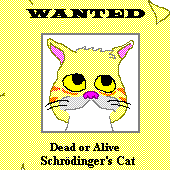|
|
|
 The
so-called "Copenhagan Interpretation," which claims
that, in essence, things are not "real" until observed,
was developed by Neils Bohr (a citizen of Denmark) in the late 1920s and was
given fame by Erwin Schroedinger in 1935 with his "cat" gedanken experiment.. It is still a valid
model today (2001) although other models are in contention. A recent (1986) book, THE
GHOST IN THE ATOM, by Paul Davies, allows eight different
physicists, each with a different model, to argue their
cases. The book by Gribbin (see below) tells the
long story very completely.
The
so-called "Copenhagan Interpretation," which claims
that, in essence, things are not "real" until observed,
was developed by Neils Bohr (a citizen of Denmark) in the late 1920s and was
given fame by Erwin Schroedinger in 1935 with his "cat" gedanken experiment.. It is still a valid
model today (2001) although other models are in contention. A recent (1986) book, THE
GHOST IN THE ATOM, by Paul Davies, allows eight different
physicists, each with a different model, to argue their
cases. The book by Gribbin (see below) tells the
long story very completely. The Copenhagan interpretation has endured so long, argues Gribbin, because of these factors:
But you'll have to read the book. I have put eight pages of it on this web site (the link is a number of lines below following a poem in honor of Schrodinger's cat).
Eight physicists argue
eight different QM models
THE GHOST IN THE ATOM, Paul Davies, 1986.
Classical book explaining physics to non-physicists
THINKING PHYSICS, Lewis Carroll Epstein, 1989
The book I recommend;
for physicists & non-physicists
SCHROEDINGER'S KITTENS, John Gribbin, 1995 (see below)
Click here for a book review
A much more difficult book on the nature of time & QM
TIME'S ARROW, Huw Price, 1996
The Multiple Universes model (for
physicists & non-physicists)
THE FABRIC OF REALITY,
David Deutsch, 1995.
(Click
here for a book review)
"If the Bell inequality is violated (which it is) then local reality must be abandoned even if quantum mechanics is completely wrong. The result of the Aspect experiment shows that the Universe is not 'local and real', whatever kind of scientific description you might dream up to describe how it works." (Italics in original).
"Philosophy attains its chief importance by fusing ...
religion and science into one rational scheme of thought."
-- Whitehead, PROCESS AND REALITY, 1929, pg 15.
"The universe is not only queerer than we can imagine,
it is queerer than we CAN imagine."
-- J. Haldane, British biologist, about 1960
The central mystery of QM is encapsulated in the two hole experiment. This easy to demonstrate physics experiment is not possible to explain using Newtonian physics. In it is the heart of QM. Feynman once wrote, in THE CHARACTER OF PHYSICAL LAW, "Any other situation in quantum mechanics, it turns out, can always be explained by saying, 'You remember the experiment with the two holes? It's the same thing.'"
The Aspect experiment, in France, in the early 1980s, showed clearly that single photons demonstrated both wave and particle properties. But photons, after all, are massless, and travel at light speed.
Japanese experiments in 1987 did the same thing with particles known to be particles -- electrons -- at Gakushuin University.
But electrons, after all, cannot be photographed. So the skeptic could still argue against QM. Few did, or do, for QM is so good at PREDICTION, even if it is not good at EXPLANATION.
Now atoms are particles, and atoms CAN be photographed. And it was at the beginning of the 1990s that researchers at the University of Konstanz, Germany, did the experiment using helium atoms. Too small yet? A year later, at MIT, the experiment was done with sodium atoms. All of these results are the same. A single atom going through two holes goes both ways at once and interferes with itself. In other words, a single atom is in both places (both holes) at the same time.
A little later on the experiment was done with even larger particles, iodine molecules. The results were the same, wave/particle duality.
By the way, there is a simple experiment you can do yourself to demonstrate the wave nature of light. Look at a distant light source through the spaces between your fingers, palm toward your face. Most people can see one, two, even three or more dark lines in the space, the result of the light waves interference as they go through the narrow slit.
In 1993 the USNIST in Boulder went a step further. Gribbin's book describes this experiment. At this point, by the way, we are at page 9 of a 250 page book. There is more -- much more --. Including the EPR "two kittens" gedanken experiment. In this one, we have two kittens, each neither alive nor dead, but in an undefined state, separated from one another by a great distance. As soon as someone looks at one, if he sees a live kitten, the other one is dead. And vice versa. But until someone looks ... . Crazy? Sure. But the experiment HAS been done (not with cats) and the results were exactly as I've described them.
Mano Singham's Opinion piece in Physics Today, June 2000
Click here
Letters on Singham's opinion piece in Physics Today:
Click here
Singham replies:
Click here
Questions for the year 2100 Click here
On Wolfgang Pauli Click here
Added 4/21/2001 -- these links
The EPR Paper
Deepening the Quantum Mysteries
Electrons and Magicians
The Alain Aspect Ph D Thesis
Added 4/25/2001 -- the original 4 page article in Physics
Review by Einstein, Podolsky & Rosen.
The EPR paper
Added 4/26/2001 -- a review of Ian Barbour's book
When Science Meets Religion:
Enemies, Strangers or Partners?
Have fun.
Burgy